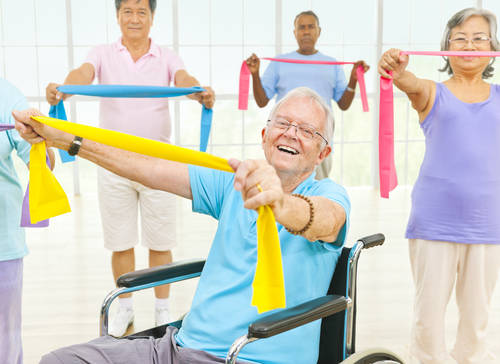 There is a common, but erroneous belief that people must put up with the loss of strength and muscle degeneration that comes with advancing age.
There is a common, but erroneous belief that people must put up with the loss of strength and muscle degeneration that comes with advancing age.
Not so, says current research coming out of the University of Michigan Health System. It is possible to halt and yes, even rebuild muscles and strength even well into the 90’s!
“Resistance exercise is a great way to increase lean muscle tissue and strength capacity so that people can function more readily in daily life,” says researcher Mark Peterson PhD, a research fellow at the UM Physical Activity and Exercise Research Lab at the Dept. of Physical Medicine and Rehab.
Through resistance training the researchers have shown that all adults can improve their ability to stand up out of a chair, walk across the floor and in general, do the things that normally require us to manipulate our bodies through range of motions, AND to do it independently.” *
Where to Begin…
The recommended starting point of a formal resistance training program is to begin by using one’s own body weight as the resistance load. Doing standing, squatting and tiptoe exercises is a good beginning place for a sedentary person and these exercises can be practiced right in your own home.
After getting used to these activities, it is time to move on to the gym! Here at Wesley Village, The Wellness Center gym is the perfect place to participate in supervised strength and resistance classes.
How Much is Enough?
A minimum of 3 days per week is the general recommendation, but exercising at 80 or 90 is not like exercising at 50 or even 60. Every adult must self-scan his/her own body to see how it feels on that day. Just a general stiffness will be helped by exercise and it is probably a good thing to do for drug-free relief.
Every adult knows his own aches and limitations. If you are feeling well and can tolerate more strengthening…go for it. It can only help you in your quest for increased strength and independence.
Strength Training for Your Brain!
For some added motivation…Exercise, particularly strength training, is being utilized in many research projects around the world as a very promising strategy for combating cognitive decline. Participants in various studies are showing improvements in associative memory tests and functional brain plasticity. Functional brain plasticity is defined as the brain’s ability to move functions from a damaged area of the brain to other undamaged areas. That means even older and damaged brains can improve! So come on down to the best little gym in Connecticut and pick up some weights for your brain!
*University of Michigan Health System, “Older and stronger. Progressive resistance training can build muscle, increase strength as we age.” ScienceDaily, 2 April 2011 <www.sciencedaily.com/releases/2011/03/110331163539.htm>

